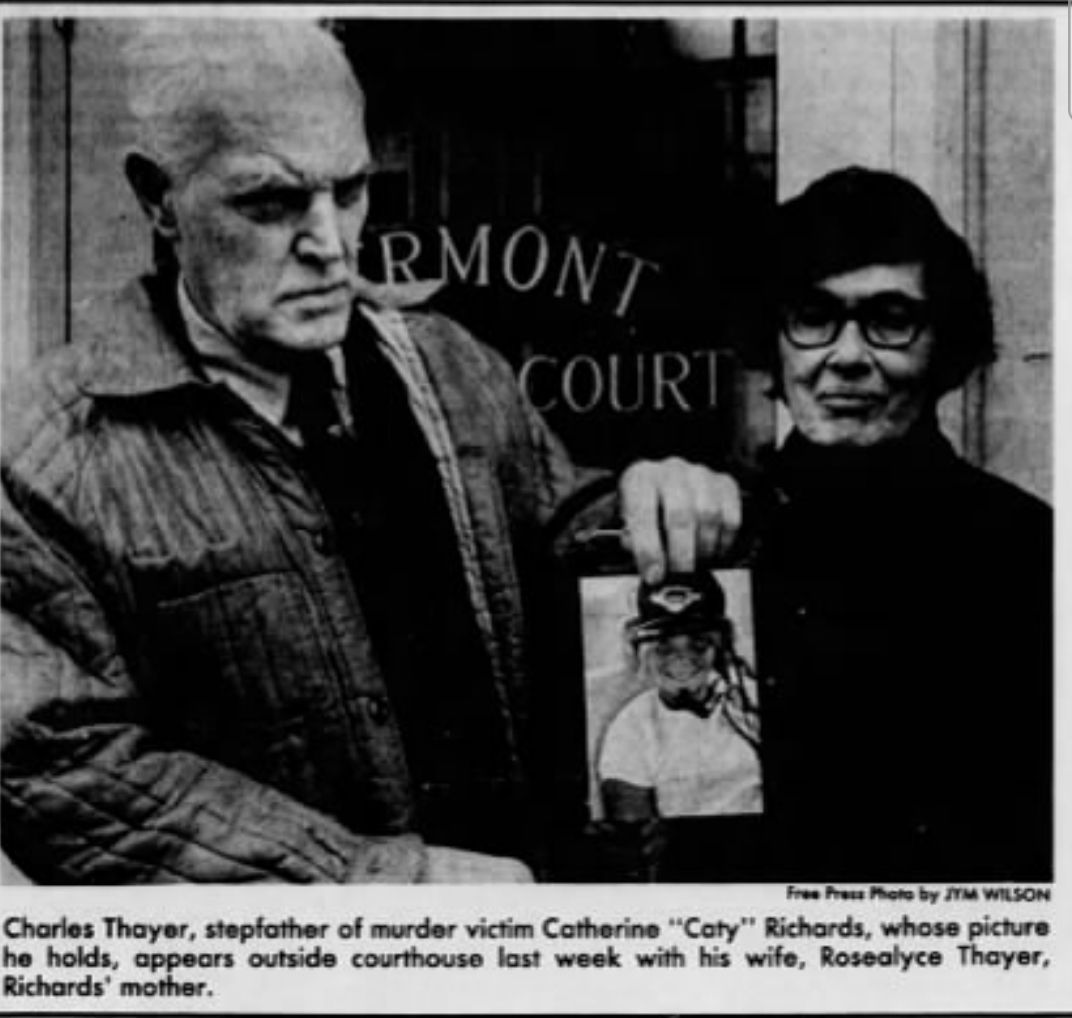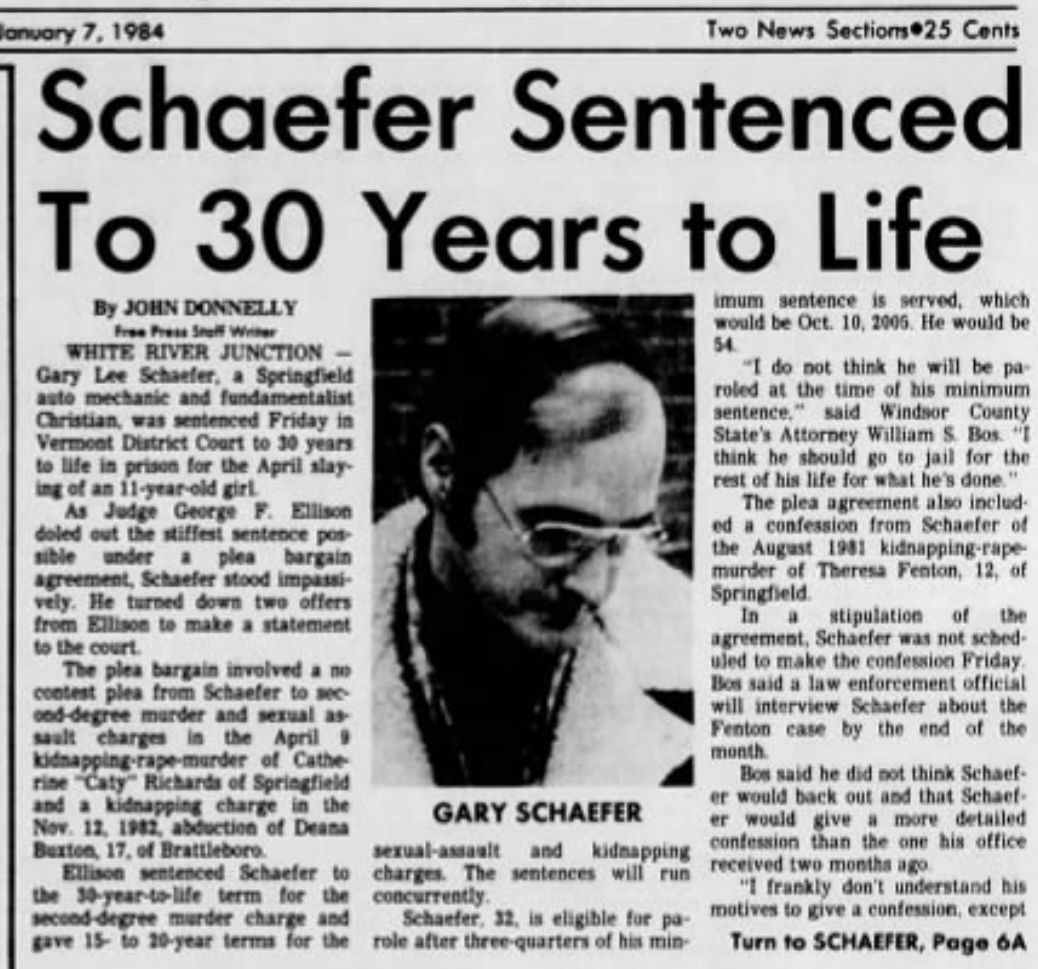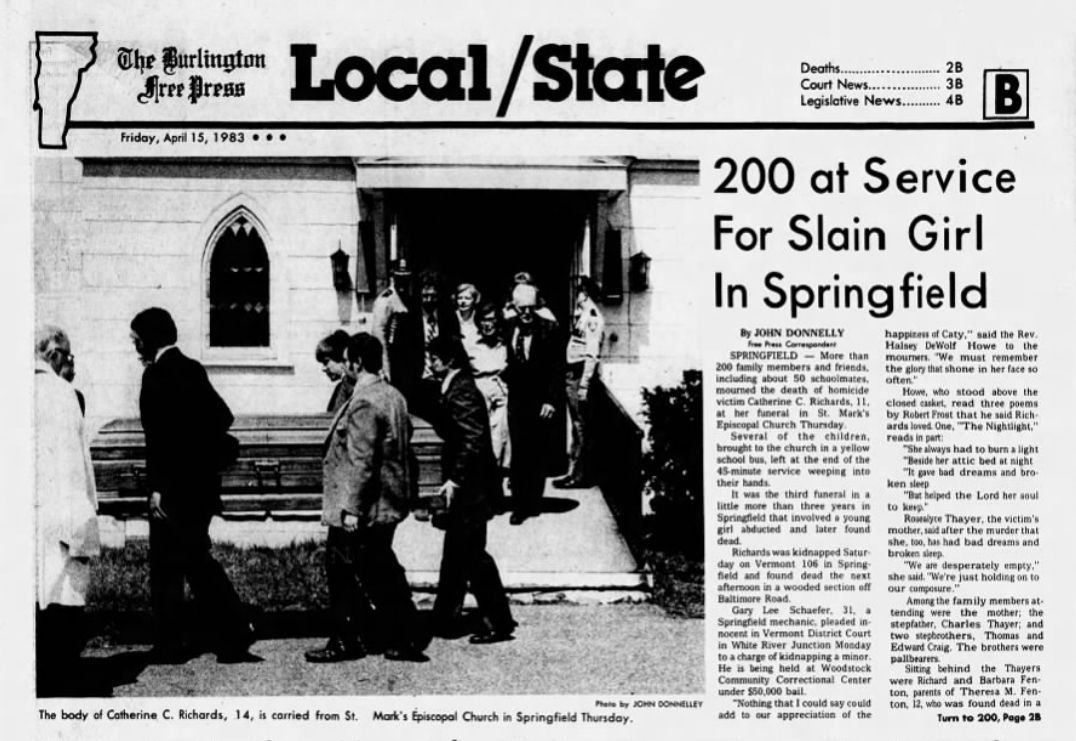Heavens'ta Betsy aka Gary Lee Schaefer: The murders of Nastasha, Theresa, and Caty
In the 1970s to the 1980s, a serial killer terrorized Springfield, Vermont.

This is the story of 3 young girls who were murdered at the hands of a predator, and the 2 young girls who put him behind bars.
Hello. I’m Rebekkah Rosewood, and this is Thrice Cursed.
Just like last week, I’m coming to you with another heavy-hitting, truly devastating case out of my dream home state, Vermont. If you’re tuning into this at work, and you either aren’t working from home, are driving, or have to deal with people… maybe hold off until you can be somewhere private, or simply safe to cry. --Hey! Simply Safe! Sponsor me?-- Anyways. I hope you got a laugh from that, because there won’t be much laughing in this episode. Seriously, I had to stop writing like 8 times because I just kept crying. Since this is a long one, I’m going to cut the preamble short, and just get into it. So, sorry in advance.
Today’s tale starts off with 13-year-old Sherry Nastasia. Sherry’s parents had been divorced, and In July of that year, Sherry and her younger brother moved to Springfield, Vermont to live with their father. Their mother lived in Florida, and their father John Nastasia was a truck driver for an oil company. He was on the road most days, and couldn’t always arrange for someone to watch his children. Sometimes they would be with a neighbor or babysitter, but most often it seems that they were on their own. Police officers in Springfield became accustomed to seeing Sherry and her 11-year-old brother outside after dark. As time went on, she was seen with her brother less and less. On August 28th, 1979, 13-year-old Sherry Nastasia was shopping in the Springfield Shopping Plaza with her younger brother, before splitting off and going out on her own as usual. Just like most nights, she had no particular plan or destination. Tonight wasn’t like most nights, though. Sherry Nastasia of 43 River St, Springfield, Vermont didn’t come home. She was reported missing the very next day and an investigation began.
Police had become familiar with Nastasia. There were some seedier parts of town that the police had grown accustomed to keeping an eye on, and more and more frequently, they began seeing Sherry there during the Summer. Police spoke to some of the people that frequented those areas, and no one seemed to know where she went. Soon enough, their investigation turned up a vague clue. A man who had a room in the same home as Nastasia (I’m guessing a renter?) said he had seen Sherry walking along River Street sometime around midnight that Tuesday. They noted that a dark green car that resembled a Pontiac Firebird had slowed beside her, and after a few moments, the vehicle stopped and Sherry climbed in. This was the only lead the police force had to go on. An official police report was finally printed in local papers on September 5th. Sherry was described in the report as “female, Caucasian, age 13, 5 foot 2 inches tall, slender build, blue eyes, and long brown hair.” She was last seen wearing a blue sweatshirt and white shorts, getting into a 1970-1974 dark green Pontiac Firebird on River Street. It was unknown at the time if she knew the driver.
A clerk in the Springfield Police Department stated that authorities were concerned immediately about her disappearance, as Sherry “didn’t have it in her nature to do something like that.” Another source I found stated that this was exactly the type of behavior Sherry exhibited, however, so I’m not too certain what to believe here. I’ll err on the side of disbelief.

Unfortunately, their concern was not unfounded. On December 13th, 1979, 3 and a half months later, a body was found in the snow by a trucker in a pull-off area along Vermont Route 103 in Rockingham, a short distance from the state police barracks. Within days, the body was identified as that of Sherry Nastasia, using dental records. According to one officer, her body was in such a state of decomposition that there had been no other methods to identify her by. The officers did their best to clear the snow and thoroughly examine the area for any evidence, but aside from the body, none was found. According to State Medical Examiner Eleanor McQuillen, several of her bones had been broken including multiple ribs and a leg. She was unable to determine the official cause of death because parts of the body were missing. Though she did conclude that she had probably died of strangulation, as the hyoid bone --the one in the neck that tends to break when someone is strangled-- was missing. Sherry Nastasia’s death certificate stated that she met a “probable violent death.” At the time this statement was released in January of 1980, police detective Robert Hains said that investigators were still working the case, but so far had turned up no leads. They’d interviewed many of the people that frequented the same places as Nastasia, even going so far as to have them take polygraph tests. Many men who provided solid alibis didn’t pass them. It’s likely this was because they had other things in their past they wanted to remain hidden from the police. A majority of them were certainly guilty of crimes, but none of them involved the disappearance of Sherry Nastasia. One of the detectives recalled “Everything that could have gone wrong went wrong, right from the beginning of that case.” Police began to feel that the case would never be solved.
Even in August of 1981, when another young girl went missing, the thought that this could lead to the man who killed Sherry was the farthest thing from the minds of detectives. The 2 crimes didn’t appear to be connected. At least, not yet.
Early on the night of August 29th, 1981, Springfield local, 12-year-old Theresa Fenton asked her parents during a car ride home if she could go on a quick bike ride before dinner. She and her parents had multiple conversations about the murder of another 12-year-old girl, Melissa Walbridge, earlier that year, and adhered to a strict safety code. --I’m just going to quickly note that the murder of Melissa Walbridge doesn’t tie into this case beyond this point. I merely included this to explain the Fenton family’s level of precautions.-- Her parents knew where Theresa was at all times, so they discussed her bike route. Theresa wished to make a 4-mile round trip from the family’s home to the Cheshire County Toll Bridge that connected Charlestown, New Hampshire to Springfield. Her mother said no, that was too far. She could do a two-mile round trip bike ride that would take her along Old Connecticut River Road and back. By the time they arrived home, the family was in agreement.
After tying a bandana over her hair and getting her bike down from the barn, Theresa had a quick conversation with her father, Richard. Then, she headed down the driveway, off on her bike ride.
She pedaled down the U.S. 5, away from her home. Part of the safety code her family had devised included situations like this. Her bike rides were always timed. Theresa had 40 minutes to return home, and a 10 minute grace period. Her mother, Barbara Fenton said “We would challenge her to do a length in a certain amount of time. That was planned to help us pinpoint problems if things went awry. If she was late, we had made an agreement to go out looking for her within 10 minutes.”
Theresa missed her 6:30pm window that evening, and within 10 minutes, her parents were out searching. The Fentons didn’t find their daughter, and the police were called. While police began to organize a search party, the Fentons, joined by neighbor Richard Craig, started a more thorough search of their own. The Fentons went in one car, and Richard, joined by a companion, went in another. Richard ended up on the river road Theresa had agreed to stick to. As it got dark, he shone a flashlight into the areas at the edge of the road where the headlights didn’t illuminate. They had been searching for about 45 minutes when Richard’s flashlight hit something reflective. It was Theresa Fenton’s bike.
By 8:30, a full-scale search was organized and mounted. Family friends, police, neighbors, firefighters, and even volunteer off-duty police officers and firefighters joined in. When word got out that her bike had been found, the search became narrowed in on that area along the river road and route 5. The search continued until 2:30am. Theresa had not been found, but the search would continue again at 6am. This search consisted of many of the people from before, but also diving teams and men in wetsuits ready to search the river, a neighbor with a helicopter who flew overhead searching roads and clearings, as well as bloodhounds. By 1:00 the divers had searched a large area of the river, still with no sign of Theresa. Everyone was convinced that had Theresa fallen, as initially suspected, there would have been some sign of her.
Bloodhounds initially picked up Theresa’s scent where her bike had been found, but then became confused and couldn’t get a trail. This suggested that Theresa may have left the scene in a vehicle.
These intense searches yielded no results. Instead, about 20 hours after her disappearance, Theresa Fenton was found by a fisherman named Torrey Walters, and his two children. She had been in a wooded section off of Mile Hill Road. This area was a remote area 5 miles from the Fenton home. She had been unconscious and half-buried, with only an arm visible in the debris and brush that covered that area. Torrey said that she had been moaning softly. It was this sound that led to her discovery. Sadly, there would be no happy ending in this case. Her skull was badly indented and smeared with blood. She never regained consciousness, and succumbed to her injuries almost exactly 48 hours after her disappearance. After medical examinations, it was confirmed she'd been beaten, sexually assaulted and left there to die. According to the autopsy report by McQuillen, Theresa’s death was caused by a blow to the right side of the base of her skull with a blunt instrument. This blow was one of six that she had received to the head. In addition to the blows to the head, there were bruises on her right cheek and lower lip, as well as a broken tooth, suggesting one or more hits to the face. There was also a scrape on her face, and a bruise on the right side of her neck, paired with an abrasion on the left side of her neck that were likely caused by strangulation.
Very little evidence was found on the Connecticut River Road she had been abducted from. The only evidence left behind was Theresa’s bike. Also noted by a new profiler, John Philpin, was the presence of a leaf found in Theresa’a waistband. Whoever murdered her had removed her clothing, raped her, then replaced her clothing. From this, Philpin was able to ascertain that the killer wasn’t frenzied, but instead calm and in control. He was also likely experienced, and comfortable with what he’d been doing. Moreso, he couldn’t help but feel that based on the way her body had been carefully placed and partially buried, that she’d been almost anointed afterwards. From this, he hypothesized that they were looking for someone who was moved by religion, “touched by ritual, a churchgoer.” He then suspected that the killer likely would have changed his behavior following the murders, be it through increased drug or alcohol use, or throwing himself into work and church services. He surmised that someone close to him likely suspected his involvement, and went even further to say that the killer likely lived with his family, and had an immature personality. He also said if the killer was on the older range of the spectrum, he had likely left the area to go to school or join the military, and that he would kill during his returns to home. He was believed to have been coddled by his mother, and either entirely neglected or oppressed by his father through either intense criticism, or even some form of physical or sexual abuse. It would be of the utmost importance to this killer to impress other people. Whoever this monster was, he was a local. When his identity finally came out, Philpin believed that the entire town would know who he was, and it would be an eye opener. Anyone could be a murderer, even your neighbor.
At this point, the entirety of the police force was working tirelessly to find her killer. Philpin even compiled the case materials and sent them over to the FBI’s relatively new Behavioral Science Unit in Quantico, Virginia. For months, they received no response save for requests for more materials. He was eventually able to get an agent on the phone who informed him that they would not be creating a profile for the case. Instead, he offered alternate theories. One was that Theresa had been sideswiped by a vehicle and knocked from her bike. This didn’t match with the carefully placed bike, her change in location, or the fact that her bike was completely untouched. Another theory was that she’d had a casual encounter with a young man who wanted more than Theresa had been willing to give. The agent described someone between the ages of 17 to 19, slow in school, and probably casually acquainted with Theresa. The third and final interpretation found the facts of the case to be consistent with an assault intended to be sexual from the very beginning. This final theory helped Philpin confirm his suspicions. His initial suspect profile was of someone in their teenage years to early twenties, but this new information from the FBI pushed him to shift the age range upwards to the late 20s or older.
Aside from these various theories, including that of Philpin, little was known publicly about the case. According to Police Captain Richard Spear, head of the State Police Criminal Division, the police had a theory. He said, “Whoever stopped the girl was able to entice her into the car, so it was probably someone she knew. It was also probably someone with standing in the community. He made a pass at her, she wasn’t receptive, and she died. So it was someone who had a lot to lose.” He reasoned that a transient or someone she didn’t know would have had no reason to kill her merely because he was rebuffed. I have to wonder if he had a reason to assume the killer had been rebuffed at all. That seems like such a huge assumption to make with little to no information. And it’s not like an assumption like that would have no impact on the investigation. When operating on the belief that the victim knew their killer, your suspect pool shifts from the entire city of Springfield to the people she knew in Springfield. Also… can we just briefly talk about that wording? What do you mean “she wasn’t receptive and she died”? She didn’t just DIE. She was MURDERED. There’s a BIG fucking difference. Finally, I have qualms with the fact that Philpin’s profile seems the most fleshed out, but he seemed to gloss over that one, and glom onto the FBI agent’s profile, even though it had been pretty clear he didn’t look too closely at the information he’d been sent. Brief disclaimer here, hindsight is obviously 20/20, and criminal profiling was still extremely new at this point. So in a way it’s understandable that little regard was shown for them. Still, in hindsight land over here, I’m the girl screaming at the television that Spear is wrong to be doing what he’s doing. Side note, can we make hindsight land a tv station that is ONLY solved cases from the perspective of someone who knows how it ends and adds in “well, duhh” statements? Also… ™. I expect royalties. Thanks.
A few weeks after the press conference, a random stroke of luck brought another detail to the forefront. Bobby Johnson, someone who had earlier contributed to the timeline of Theresa’s disappearance, was arrested on charges of possessing and intending to sell drugs. In hopes of leniency, his recollection of that night became clearer. He had seen more than just the girl on her bicycle approaching the cross section of the road like he’d initially told police. This time, he informed them, he had actually looked at Theresa through his rear-view mirror and noticed a car. This car had slowed down, stopped, and eventually backed up towards the girl on her bike. He lost sight of both the girl and the car at that point, but he was able to tell them one important piece of information. The vehicle had been a Pontiac Sunbird, and it appeared to be a dull gray. He also informed police that the license plates appeared to be from New Hampshire. A polygraph test indicated that Bobby Johnson was telling the truth. This did cause a bit of a conundrum, however. Other witnesses who had seen a vehicle around the time of Theresa’s disappearance had indicated that the car was red. Regardless of the discrepancy, Philpin was now set in his profile. This was in fact an older man, and he’d likely killed before, and likely would again.
While the intensity of the investigation dwindled due to a lack of new leads, investigator Joseph Estey stated, “I do something in the case at least every day that I’m working. I still feel very strongly that we will find out what happened. I have some doubts about a criminal conviction at this point.”
Flyers with Theresa Fenton’s picture and an offer of a reward for the capture and conviction of her murderer were placed around and inside of local shops and markets. A $10,000 reward had been put together with pledges and contributions by hundreds of people. By August of 1982, however, Bruce Lawlor, the Springfield lawyer and state legislator who handled the reward fund, said that there had been talk of withdrawing the offer and donating the money to a charity instead. He was quoted as saying, “I think there’s still a lot of intense feeling, but I think it’s under the surface a little bit. It’s not as apparent as it was following the killing. The primary purpose of a reward is to produce information that might lead police down the right path. The chance of that type of information surfacing after a year decreases substantially. If anybody was going to come forward, they would have done so by now.” --I take issue with this line of reasoning. Obviously this was a different time, but nowadays we hear about so many cases where someone who was terrified to come forward eventually does so, 5, 10, 15 years later. I would hope that if my child were to go missing, people wouldn’t renege their donations because the sense of urgency and pain became distant to them.
Speaking of distance, you’re all SO exhausting. I’m going to take a quick break and I’ll be right back!
------------------------------------------------------------------------------------------------------------------------------------
Alright, my social bar has been restored. I feel like a Sim character, only instead of a social bar, I have an antisocial bar. Like I can only socialize so much before I have to retreat. It's like a recluse recovery. Anyways...
Fear was likely renewed in November of 1982. At the time, Deana R. Buxton, also referred to as Dana Thurston in “The Shadow of Death: The Hunt for a Serial Killer,” by Philip E. Ginsburg (which is where I get the majority of my detailed information from in regards to Deana’s experience), didn’t think twice about hitchhiking. She did it often enough, and she had places to be. On November 12th, she was hitchhiking again. She had hoped to visit her boyfriend, Jerry Twitchell, at the prison in Rutland. The prison was about 50 miles from where she lived in Battleboro, and too far for a walk. She headed out to get a ride midmorning, and figured she could be back by dark if all went according to plan. It did not.
Her ride began when she was picked up by a man in a green van. He took her the first stretch of the way, north up Route 5 to Putney, putting her close to an interstate along the Connecticut River. She walked to the interstate and waited. She didn’t wait long though, within 5 minutes, a man in a blue Nova picked her up and brought her to Rockingham where Route 103 led toward Rutland. Rockingham was just south of Springfield. She waited for her next ride. It came along within about 15 minutes. A man in a red car with Vermont plates welcomed her into his vehicle. He appeared to be of average height, maybe five-foot-eight. He wore a checkered flannel shirt, and had short, brown hair with that old-person side part. --I’m looking at you gen-z tiktokers. I heard what you said.-- He wore wire-framed glasses and appeared to be in his early 40s. He’d asked her questions about herself, learning that she was a ward of the state. She said that all of her problems were behind her now that she was 17, and didn’t go into much detail. Which was fine. He was comfortable filling in the silence. He told her he’d been divorced and had 3 daughters. He also told her he’d been in the navy, and was shot in the shoulder, ankle, and left hand. He didn’t elaborate on this. He also told her that his name was Stan.
Less than an hour into their drive they passed the highway sign Rutland, 13 miles. A little past this, Stan pulled off to a rest stop, saying he needed to use the restroom. After getting out of the car, however, he didn’t head toward the restroom. Instead, he reached behind the driver’s seat and pulled out a shotgun. He then pointed the two barrels directly at her, saying “Don’t try to run away or scream or I’ll kill you.” He then got back into the driver seat and opened the bolt, showing her that the gun was in fact loaded with 2 green shells. “You know I’m not fooling around,” he said. “It only takes one trigger and you’ll be dead. So do what I say or I’ll kill you.” Deana was convinced that he meant every word of what he’d said.
Quick trigger warning here, we’re about to take a turn towards the rapey material. It’s definitely uncomfortable, so if you need to skip this part I’ll definitely understand.
The drive continued, with the barrel of the shotgun remaining trained on her head. The topic took a shift from the previous small talk. Now, he had sex on the mind. He grabbed a bottle of Colt 45 malt liquor and ordered her to drink it, saying “We’ll get drunk and then we’ll have some fun.” He then ordered her to remove her under garments, then put her shirt and jeans back on. She complied, all the while begging him not to hurt her. He replied, “As long as you do what I say, there won’t be any problem.” Her under garments as well as her vest were thrown into the back seat. He continued to talk to her about things like masturbation, oral sex, and intercourse. He was sure to use the more vulgar terms for all of these things. Through all of this, he continued to insist she drink. He intended for her to be drunk.
With one hand on the wheel, he began reaching over and groping her. When he tried to force a hand into her pants, she shoved his hand away. He immediately switched the subject to war. Not so much the subject of war itself, but what happens when men are off to war. More specifically, when fighting men have women at their mercy, raping them at will. He then informed her that he liked raping girls and he wouldn’t have any qualms about doing the same to her, or killing her if she refused to cooperate. He also told her that she wasn’t his first. He’d done this to others, and had been forced to kill 2 of them.
Now just 20 miles north of where he’d picked her up, he pulled the car over once more. The amount of fear coursing through Deana’s veins must have been paralyzing. She was ordered to take over driving. With him no longer focusing on the road, his hands were free to do what they wished to her. --I have to take a second to applaud this girl. Hands down, I would have been so messed up in this situation that I would have immediately crashed the car. And not even on purpose. Deana didn’t crash the car, though. Instead, she continued driving as his hands, and even his mouth, violated her. By this point, they were almost out of the malt liquor, as Stan had been drinking it as well. He directed Deana to take the White River Junction exit, and take him to a liquor store.
The two entered the liquor store together, Stan keeping Deana close to his side. While he was making his selection, Deana did her best to get help from a store clerk. She managed to mouth “please help me,” while gesturing to the man beside her. The clerk didn’t understand, even when Deana continued. Before she could come up with another plan, Deana found herself back in the vehicle with the man, with Stan behind the wheel. It was now that she realized, if she didn’t do something fast, she was going to be his third victim. He would rape her, then he would kill her.
Thinking fast, Deana said she was feeling unwell, like she was going to be sick. Not wanting her to vomit in his car, he stopped at the curb in front of a small store in the business district of White River Junction. He told her to run in and get herself some Rolaids. He would be right there. Watching. And then he reminded her that he had a gun. --As if she could forget. Whether Stan was convinced she was too afraid to disobey him, or he’d actually convinced himself she was enjoying his company is unknown, but he didn’t accompany her into the store.
In the store, Deana counted the customers. There were 3 men, and 1 woman, as well as the woman behind the counter. In the store, she cried, “Help me, he’s going to kill me.” One man had heard her as he was paying for his items, and walked out the door. Deana felt the hopelessness of her situation, until the man at the door waved to her, trying to signal her to come over. She did, grabbing the man and begging him to help get her away from Stan, whom she pointed to. The man -- my fucking hero, honestly-- just glared angrily down at Stan and yelled “What the fuck are you doing to her?”
Ever the liar, Stan replied “I don’t even know her.” Not hearing a word he’d said, Deana ran back into the store and told the clerk to call 9-1-1, there was a man with a gun, and he was going to shoot her. Officer John Halpin was called to the Progressive Market. He’d been told by dispatch that a girl had become hysterical, claiming a man with a gun was trying to kidnap her. --I’d just like to say fuck you to that dispatcher. I understand “Thems was the times” or whatever, but no.
In the 3 minutes it took Officer Halpin to get there, her captor had driven away. The only man who had believed Deana, and even defended her against him, had also disappeared. She and this man were the only 2 people to get a good look at Stan. It quickly became clear to Officer Halpin that Deana wasn’t “delirious” but terrified, and she had in fact been kidnapped. She was brought into the station to give a statement.
She turned out to be an extremely observant witness, giving officers a thorough description of the man, down to the moles on his face.
After the parking lot fiasco, a very inebriated Stan continued to drive the roads he knew so well until the alcohol really began to hit. Then, he pulled off to the side of a road for a nap. The nap didn’t seem to help, however. When he awoke, he continued driving and came up on a curve too fast. His car went off the road and ended wheels up. And before you get all happy about it, he lived. I know. Despite not wearing a seatbelt, Stan survived the crash. He flagged down a passing woman and asked her to call the police.
Once the woman had left, he realized that there was a lot of evidence in his car that could get him into trouble. He set to work quickly grabbing anything he could get his hands on. He didn’t stop to think about what he could keep versus what he couldn’t and just grabbed anything he could. Once his hands were full, he went deeper into the woods. Approximately 200 yards from his car he created a very shallow hole and dumped the gun and other items into it before covering it with some dirt and leaves.
A few moments after returning to his car, State Troopers Dan Lavoie and Warner responded near the end of their shift. They took down the information about his accident. The name on his driver’s license read “Gary L. Schaefer.” The car was a 4 yr old Pontiac Sunbird, a sporty red one with a white top. The car had been essentially totaled. Now if you’ll remember, the car used in Theresa Fenton’s murder was described as red by some witnesses, but grey by Bobby Johnson. Regardless, the two officers who were now eating into their free time as their shift had ended, didn’t put the pieces together. Lavoie finished filling out the accident report and threw it in a basket before heading home.
So with a police report, you would think that the case was close to being solved, right? Wrong. The Vermont police department, at the time, had their troopers working long hours when they were on duty, as well as being on call even when they were off for 5-7 days. Then, they would take 3-4 days off. This shift was Lavoie and Warner’s last before a long weekend. Over the next few days, while these two officers were off duty, dispatchers sent out broadcasts about “Stan.” Printed notices were put up on station bulletin boards with a description of the man, as well as the vehicle he’d been driving. Deana was so observant, she was even able to tell police that his vehicle had a pink inspection sticker dated July 24th, 1982. There was a Playboy bunny sticker on one of the windows, and a sheepskin cover on the driver’s seat. Even with all of this information, she wasn’t sure on the make of car. She described it as small and sporty with a white top, like a Mustang, maybe. Now, all local law enforcement was looking out for a vehicle that matched this description. That Saturday, newspapers printed a report stating that “police were on the lookout for an armed man driving a red Mustang car.” Now, police were searching for a red car with a white top, while the public searched for a red Mustang. Police were now searching for a vehicle that had just been totaled, and now sat behind a Sunoco station near the junction of the interstate and Route 103, which was approximately 10 miles South of Springfield.
By the time officers Lavoie and Warner returned from their time away, the bulletin had become one of the “less-urgent” matters and was no longer at the top of everyone’s to-do list. And if you’re wondering why the accident report didn’t capture anyone’s notice, there was no place on accident reports for writing down the color of the vehicle. Should anyone have happened upon it, it would have just appeared to have been a Pontiac sunbird.
Despite the attempted abduction and all of the information Deana was able to give police, as well as the continued focus on Theresa Fenton’s case, the final ground-breaking clue wouldn’t come until 19 months after Theresa’s murder, and 5 months after the attempted abduction of Deana Buxton.
Unfortunately, this clue came at the price of one more young girl’s life.
On Saturday, April 9th, 1983, Caty Richards went across town to spend time with her friend, Rachel Zeitz. The pair of best friends were both 11-years-old, and had made it through 2 dance rehearsals that day for an upcoming recital. Now they had time to enjoy themselves and maybe relax a little. The 2 girls begged Rachel’s mother, Judy Zeitz, for permission to go to Athens Pizza III to play an arcade game. Initially, Mrs. Zeitz said no, but later acquiesced. Like Theresa Fenton’s mother, and many other mothers in Springfield, her hesitation came from the recent murders of multiple young girls in the area. Still, the arcade was only a 10 minute walk down Plain Hill Road from the Zeitz home. I’m sure there was likely some false comfort felt due to the close proximity. We all tend to fall victim to the “not in my neighborhood,” trap. Home is safe.
Rachel’s father checked his watch as the girls went out the front door. It was 4:47pm when they left for the arcade. The girls arrived at their destination just before 5, hoping to have some fun. They had wanted to play Ms. Pacman, but some of their friends from school refused to give the 2 newcomers a turn. Instead, they grabbed 2 small bags of Doritos and headed for home. One girl wouldn’t make it home.
As they were walking, Rachel noticed that one particular car had gone past them 4 or 5 times. That car was a J-2000 Pontiac. They continued on though, and were rounding a curve in the road on Pedden Road. This area wasn’t visible from the main road, Vermont 106, or the nearby Pedden Acres development. It was here that the car stopped alongside them at around 5:15pm.
Caty asked the driver if he was lost. The driver then asked for directions to the home of someone named Joe Cerniglia. After being told that the girls didn’t know who that was or where they lived, he asked how to get to the Springfield Racquetball Club. They were familiar with this location, and Caty gave the man directions. As she did so, the man got out of his light blue vehicle. There was something in his pocket, though no one know what.
Rachel recalled that the man questioned, “What if I tell you if you don’t get in the car, I’m going to kill you?” Immediately, she turned and ran up the road. When she turned back to check on her friend, she saw Caty Richards climb into the driver’s seat. This would be the last time that Rachel Zeitz, or anyone aside from her abductor, saw Caty Richards alive.
Immediately, Rachel returned home and told her parents what had happened. Mrs. Zeitz called Caty’s mother, RoseAlyce Thayer, and the two women went to the police. What followed from there was hours of interrogations, before Mrs. Thayer was informed by Police Chief Peter Herdt that there would be no search for Caty. --I know. What. The Actual. Fuck? I wish I could tell you that there was some sort of GOOD explanation for this… but there honestly isn’t. And it’s going to get a lot worse, so just buckle up. This case in general, plus this particular aspect of it, has made me so livid that I had to stop researching and writing like 10 times in the making of this episode because my blood pressure was just absolutely done.
During this time, the man Caty knew as dad, Charlie, was hurrying back from a meeting out of town. It was still light out, so he was hopeful that he could take his private plane out to conduct an air search of his own. Herdt ordered Mr. Thayer not to do so, and even went so far as to send a police officer home with the terrified parents to monitor their phone and ensure they didn’t call others to begin a search. The officer also blocked their driveway with his car to prevent them from leaving to conduct a search.
In a later lawsuit against Herdt, Mrs. Thayer maintained that Herdt told her there would be no search for her daughter the night of her abduction “because searches destroy evidence.” She also alleged that Herdt told her, “We know who he is. After we find her body, we’ll get him.” This lawsuit ended in a settlement, supposedly because it was cheaper to pay out than to continue paying for a defense. I think the lack of a search combined with the payout tells us all we need to know. Many believe that Herdt’s perceived prioritization of evidence over preservation of life stemmed from the unsolved murder rate in Vermont at the time. Between 1957 and Schaefer’s first murder, the killers of more than 30 people had eluded capture. In many of those cases, police believed they knew who the killers were, but didn’t have the evidence required to build a strong enough case to make an arrest.
According to an article in The Burlington Free Press, it took Springfield police more than an hour to notify state police of Caty’s abduction. No roadblocks were set up, and instead of dispatching police to patrol the area, they were sent door to door in the area of the abduction. Mrs. Thayer argued that police treated the disappearance as a missing persons case, rather than a kidnapping. A claim I would have to agree with given the information I was able to find. The Police Chief, Herdt, continued to pat himself on the back, however, saying he was “very, very pleased” with the department’s response. “We were very rapid.”
19 hours after her abduction, around noon on Sunday, Caty Richards was found in a wooded area 2.2 miles from the abduction site off of Baltimore Road. Her parents weren’t called. Instead, Mrs. Thayer called the police around 2pm. She recalled that Herdt told her, “We have found the deceased body of a young girl wearing her clothes on the Baltimore Road. You cannot go there.” McQuillen was the medical examiner in this case as well. The autopsy report said that Caty Richards’ death was caused by one blow with a blunt instrument to the back of the head. Unlike with the other girls, this was the only head wound according to the report.

Around the same time Caty’s body was found, police were gearing up to make an arrest, led to the suspect by Rachel Zeitz. She gave police the exact description of the man’s car, as well as that the assailant had tinted yellow glasses with wire frames, and was about her father’s height. She also recalled that the man had been wearing a bright red sweatshirt with lettering on it. She said, “I thought it was some kind of football shirt. I thought it said ‘The Dolphins.’ I remembered, though, that my friend Joel DeLorenzo had one just like it.” After receiving this information, police went to the DeLorenzo home and found the aforementioned sweatshirt. The lettering on the front had not said “The Dolphins,” but instead said, “Christadelphians.” Within Springfield there was a Christadelphian church, which had only 60 members. This sweatshirt was associated with a specific youth gathering they had put together.
Police pursued this lead and began calling some of the group’s leaders. By that Sunday, word had spread through the church that the police were searching for one of their members. One of the Christadelphian leaders police spoke to, James Millay, recalled that he had seen church member Gary Lee Schaefer driving near the area close to the time of Caty’s abduction. As police continued making phone calls, Sunday services were convening. Schaefer was in attendance. Upon his arrival a little after 9am, one of the teens who had attended the gathering greeted him. She’d grown close to Schaefer, as he’d been especially friendly to her, even advising her about life. The pair had long heart-to-hearts, and he’d even written letters to her that referred to the bible and popular songs to help teach her life lessons. She’d even seen Schaefer the day prior around 3pm. At that time, he’d confided in her, saying that he was unable to see his adopted daughter’s baby, and he was quite upset about that, as well as tomorrow being the anniversary of his father’s death.
This perceived closeness caused her to jokingly ask him on Sunday morning, “Hey, are the police after you, too?” She then explained that police were asking about the sweatshirts. He excused himself to the bathroom, saying he wasn’t feeling well, where he purged the contents of his stomach. --I’d just like to address the fact that Deana Buxton didn’t even throw up while he had her hostage, and was threatening to rape and murder her. But here’s this little bitch, throwing up when he’s literally being given a heads up. And that’s in no way me saying that someone who throws up in times of duress is weak. I just think that Schaefer here is being a little troglodyte.
While this occurred, Detective Mike LeClair met with James Millay. He showed James the composite sketch made up from Rachel Zeitz’ description of Caty Richards’ murderer. Millay took one look and said, “Oh sure, that looks just like Gary Schaefer,” who by the way, is James Millay’s cousin. James was then able to give police a time frame, as well as confirm that he had been wearing his Christadelphian sweatshirt, and driving a light blue vehicle.
After his little fit at the church, instead of doing the intelligent thing and getting the fuck out of dodge, thankfully, Schaefer returned home. At almost the same time the discovery of Caty’s body had been made, Mike LeClair and another Springfield detective, Doug Johnston arrived at the Schaefer home. Several police waited in cars outside the Schaefer home, out of view of the residents, but ready to jump into action should they need to.
The officers were let into the home by Schaefer’s mother, whom he lived with, who then called up to her son in his room. The first words out of his mouth were, “I’ve been sick,” before he excused himself to the bathroom once more. He again threw up as police listened through the door. They’d been expecting some kind of escape attempt, but there was none. The detectives sat down with Schaefer and asked him about his whereabouts that Saturday. Schaefer, who worked as a mechanic for Thomas Soucy, a car dealer in North Springfield, said he had been with his boss in Rutland, picking up cars for the dealership. He’d said that the cars were actually late in arriving, so they hadn’t arrived back home until sometime after 9’o’clock. His mother, who stood nearby, confirmed that he had left around 2pm and returned around 9:15pm. She told police he’d been wearing blue plants and his red Christadelphians sweatshirt. He’d also been driving her car, a light blue pontiac J2000.
The officers allowed Schaefer to finish his version of events before informing him that they had already spoken to his boss. His boss had said that Schaefer had not been with him at that time. They also informed Schaefer that a witness had placed him in town around the time of Caty’s abduction. Gary Lee Schaefer was then placed under arrest. He went without a fight.
After his arrest, LeClair and other officers searched Schaefer’s home. His sweatshirt, the official Christadelphian sweatshirt, was taken from his bedroom as evidence, along with a pair of blue pants believed to be the ones he was wearing when Caty was taken and subsequently murdered. On these pants they found a hair that looked to be the same color as Caty Richards’ hair: dusty blonde. Schaefer was held at the Woodstock Community Correctional Center under $50,000 bail on a charge of kidnapping a minor.
The investigation for more evidence was in full swing now. After the discovery that the composite sketch of the man who molested Deana Buxton closely resembled Schaefer, police set to work locating his vehicle, the one he had crashed. Now that they had a name, it was easy enough to connect the dots. Caty’s murderer was driving a blue car because his red one had been totaled. On Tuesday April 12th 1983, the police impounded Schaefer’s vehicle, which had been moved from the Sunoco station to a junkyard in Rutland, where it sat untouched for months. The car was obviously in a state of disrepair, but Deana was able to confirm that it was the vehicle she had been in. The colors were the same, the playboy bunny sticker was where she’d remembered it to be, and her denim jacket and red and blue vest were still in the car. It seems that when Schaefer, drunk and in a panic, attempted to clear evidence from his vehicle, missed some crucial pieces.
Herdt said at a news conference the following day that stains “resembling blood” had been lifted from Schaefer’s car. The stains were to be tested by the state crime laboratory, Herdt felt “optimistic” that the stains would connect Schaefer to the murder of Theresa Fenton. State Police Sgt. Robert Hains also stated that on that very morning, two state police divers searched a small pond near the site where Caty Richards’ body was found for a murder weapon. This search proved unsuccessful. Herdt then acknowledged that the weapon was difficult to narrow down, as it could have been any blunt instrument, including a rock.
At this point, Windsor County State’s Attorney, prosecutor in this case, William S. Bos, stated that Schaefer was “so significantly depressed as to be considered a suicide risk.” He was placed in maximum security away from the general prison population, and was under close watch.
At his initial hearing, Schaefer arrived wearing dirty white sneakers, brown pants, and a flannel shirt. Real good look there, pal. At this hearing, he pleaded not guilty to both the kidnapping of Caty Richards, and the kidnapping of Deana Buxton. No further charges were filed against him at that time, as they still lacked the evidence required to meet a murder charge against him for Caty Richards. As of May 5th, they were also no closer to tying Schaefer to the murder of Theresa Fenton.
In a news report from May 5th, Prosecutor Bos said that the samples taken from Schaefer’s vehicle, as well as samples taken from his boots turned up blood. He didn’t elaborate on whose blood it might be, or which sample if not both, the blood had shown up in. He did, however, say that he knew the blood types that were pulled in the sample.
Further information regarding the multiple cases here is sparse, as a gag order was placed on any information regarding Schaefer in order for him to receive a fair trial.
In early October, Schaefer apparently wrote prosecuting attorney, Bos, a letter, stating that he “believed” he had murdered Richards and Fenton.
On Monday December 5th, 1983, Gary Lee Schaefer said through his attorney in a Vermont District Court that he wished to clear himself in the eyes of God. Don’t be fooled though, this wasn’t about God. He changed his plea from innocent, to no contest to second-degree murder, sexual assault, and kidnapping in a plea-bargain arrangement. A stipulation of this plea bargain was that no charges could be filed against Schaefer in connection with the kidnapping, rape, and murder of Theresa Fenton, provided Schaefer wrote a detailed confession of her murder.
Bos said that his case had been weakened when a discrepancy in the Vermont law statutes dismissed a felony-murder charge against Schaefer in regards to Caty Richards’ murder. This prevented a first-degree murder charge. Schaefer’s attorney said during the hearing that he had “substantial evidence” to prove that Schaefer had been temporarily insane when he killed Richards, and that it was his client’s desire to go ahead with the plea bargain. He stated that Schaefer had no recollection of trying to harm Caty, and that “It is his belief that he was acting in a way that had an interrelationship with things that happened to him as a child.” This statement was not elaborated on.
It came out in this trial that Caty Richards had also been raped prior to her murder.
According to Mrs. Zeitz, during the entirety of the trial, Rachel insisted upon sitting in the front row. “She said she wanted to get a good look at him.” She stared at Schaefer for most of the sentencing. When Rosealyce Thayer took the stand, she said, “As long as this man lives, he will feel compelled to destroy the lives of innocent children by as odious and obscene means as he can devise. I don’t want any child so tortured such as she was ever again. He must never be allowed near another young child.” Schaefer’s lawyer insisted, “Some may be skeptical about this, but Gary understands that society should inflict punishment upon him. I suspect the court knows that he’s likely to feel more pain from his sense of guilt and sense of confusion than from any sentence.” I’m going to say that I fully understand that defense attorneys, even of the guilty, are doing an extremely important job. An inadequate defense could lead to cases being thrown out, and killers being set free. It’s happened far too many times. But the fact that he said this JFWBF is more likely to feel any pain at all from a sense of guilt or confusion is simply vomitus to me. He won’t even vocally state that he FOR SURE did it, just that he thinks he might have. Like I’m sorry, but bruv doesn’t feel any guilt over it.
In January of 1984, Schaefer was sentenced to the maximum term for murder at that time in Vermont 30 years to life, with the possibility of parole. Bos stated, “I do not think he will be paroled at the time of his minimum sentence. I think he should go to jail for the rest of his life for what he’s done.”

So who was Gary Lee Schaefer?
As far as most in the town were concerned, Schaefer was unremarkable. He lived a quiet life, and had no real social life outside of the church.
His documented childhood was rather uneventful. He’d moved to Springfield with his family when he was around 10 years old. Philpin’s spot-on profile of Schaefer, combined with the statement from Schaefer’s attorney do imply that there may have been some darkness in his childhood. Whether that was the physical or sexual abuse, or the emotional abuse inflicted by an overcritical or absent father, no one knows.
After high school, Schaefer served in the Navy for 10 years. All that is known about his performance in the Navy was a single note someone had written on an affidavit submitted at his arraignment. The notation read, “had trouble in navy.” Police opened investigations into missing or murdered girls in any area he’d been stationed at. I could find no information in regards to these investigations, or whether or not anything was turned up by them. I can only surmise from the lack of documentation means nothing came of them. I could be wrong. Or, the cases could have simply not been tied together yet.
Schaefer returned to Springfield, Vermont 2 years after his service ended, and rejoined the Christadelphian Church. Reports here differ slightly. In one report I found that Schaefer had been disfellowshipped from the church for marrying Arlene Schaefer in 1972, which went against church rules regarding marrying a divorcee. The book I referenced stated that he’d recently been elected as a custodian of the church. Either way, he was a highly active member of the church who attended Sunday services, as well as Wednesday night prayer meetings. Unsurprisingly, he also paid special interest to the youth group. In fact, 3 days out of the week, he would take groups of young people to visit with the elderly at nearby nursing homes.
Friends and family of Schaefer stated that there were two sides to him. There was the Gary they saw at church, and the Gary they saw outside of it. At church, he was outgoing, friendly, and dedicated to the youth. At his job and in his social life outside of church, he was “quiet, almost a recluse.” According to his friends though, he loved to go on drives in his car, blaring rock ‘n’ roll as he went.
This next part I’m only including because it grossed me out and if I have to live with it, so do you. According to Roger Schaefer, Gary’s brother, when Gary was stationed in the Navy at Great Lakes, he became attached to the band Styx. Apparently, Schaefer would tell people that their song called “She Cares” sort of described his life. Why does this gross me out? Well… here’s part of the lyrics.
“I worked hard to be the greatest lover. I wanted to be sure I was her only one. That’s how I thought it was to be done. But I went too far, assumed too much. The need to feel a younger one’s touch. Seemed important then. Oh what a fool I’ve been.”
On its own, it’s pretty obviously a song about a guy cheating on his partner with a younger lover. Shitty, but.. Okay I guess. But when pairing those lyrics with Gary Lee Schaefer, knowing what we know now… it’s simply VOMITUS.
In one interview, Roger also told police that Schaefer and his wife, Arlene, had been in Springfield the weekend of Nastasia’s disappearance, and may have stayed at the Howard Johnson Motel. A manager of the hotel was unable to locate the records for the nights between August 27th and 29th, 1979, and Arlene Schaefer declined to comment.
Since his initial statement, John waffled. He said that he no longer believes that his brother had been in Springfield at that time. Roger said, “That’s what he tells me, that he wasn’t here that weekend. I know he came up sometime during that period, I just don’t know when. I really couldn’t say, to be honest with you, whether he was in town. I can’t see why they would want to pin it all on Gary… But if he was in town and, I knew for a fact, I would suspect it myself. I really don’t know. I really don’t.” Frankly, I wouldn’t believe anything one of my siblings said if I found out they were, without a doubt, raping and murdering people while living under the same roof as me. Or on Pluto, for that matter. They would just lose all credibility in my book.
It should be said that despite his uncertainty, Roger made himself available to the police to try and clear things up as best he could.
At the time of his arrest, Schaefer was divorced, and living with his mother, and his brother Roger. His, and their mother’s feelings towards Gary remained very clouded and confused.
Gary Lee Schaefer died on December 3rd, 1995 in Florida State Prison. I can’t say that I think many tears were shed for him. He’d been stabbed multiple times by another inmate. He had over 40 stab wounds to his eyes, and his throat had been cut from ear to ear. CORRECTION: I mentioned that Schaefer had been stabbed to death by a fellow inmate. That was incorrect. I somehow confused Gary Lee Schaefer with Gerard John Schaefer. They’d both been in prison in Florida, and I messed up. I apologize. It’s my goal to get the information right every time, but I’m only human and tend to mess up sometimes. Tracking down Gary Lee Schaefer has been difficult as hell, but the person who brought this to my attention said that according to his mother’s obituary in 2008, Schaefer was still alive and kicking. I could find nothing beyond this. I’d like to say a quick thank you to Caroline for providing me with this information and bringing it to my attention. I truly appreciate it.
Peter Herdt lost his position as police chief after the lawsuit was settled, and went off to be head of security on a college campus.
Sherry Nastasia was just 13 years old at the time of her murder. I couldn’t find much by way of statements about her, but from my research I gather that she was a loving older sister, and a fiercely independent young girl.
12-year-old Theresa Fenton was described as bright and perky, and “an exceptional student, very good in all her classes.” She was active in the chorus, cheerleading, and band. She had also been named Student of the Month several times in 6th grade, and was looking forward to beginning junior high the Wednesday following her death.
Caty, 11 years old, had just been named Student of the Month at school, and had been looking forward to her 12th birthday. She’d also been looking forward to her upcoming dance recital, and wearing a special tutu with sequins her mother had made specially for the occasion. Caty was buried in the tutu that she loved, never having gotten a chance to perform in it.

This has been the cursed, and excruciating tale of the brutal murder of 3 young girls, and the sexual assault of another, at the hands of some fucking guy who couldn’t cope with his bullshit problems. I know, that wasn’t at all catchy. I’m honestly just so pissed off and sad that I couldn’t come up with anything else. So, sorry.
Hug your loved ones a little harder today, or… zoom them harder? That’s not a thing, but… you get me.
For more cursed content, you can find me on Instagram and Twitter at ThriceCursedPod. For just $5 a month you can get ad-free episodes on patreon, plus access to a patron-only discussion channel in the discord server! Or for only $2 a month you can earn all of my love. There aren’t any perks beyond keeping me caffeinated to write 16-page scripts such as this one. You can also get your hands on some Thrice Cursed Merch on ThriceCursedPod.com. I also learned something super fun! On my website, you can become a member so you can get emails letting you know when there’s a new blog post, as well as actually being able to comment on the blog posts! So, definitely do that while you’re checking out the photos for this week’s episode. Finally, don’t forget to join us in the facebook fan group by clicking the Facebook symbol on my website. It’ll take you straight there. It’s a little quiet right now, but I’m hoping we can start getting some fun conversations going. Alright, that’s all I’ve got. I’m going to go drink like 8 glasses of wine now, or something. Anything to take the edge off at this point. Meth maybe? Kidding!
Until next time, keep your curses hexy and your hexes sexy.
I could sadly find no photos of Caty Richards beyond what was posted here, and I could find none whatsoever of Theresa Fenton or her family. No photos of Deana Buxton were made available either.
UPDATE
On November 26, 2023, Gary Lee Schaefer died at the maximum-security Kentucky State Penitentiary in Eddyville, Kentucky. At the time of the press release, it was stated that there did not appear to be any suspicious activity involved.
Sources
Bureau, W. (1979, September 05). Police Report Girl Missing In Springfield. Rutland Daily Herald, p. 7.
Christensen, A. (1984, September 24). Brothers Team Up To Fight Crime. The Times Argus, p. 6.
Daley, Y. (1992, September 27). Vt. town settles suit over killing. The Boston Globe, p. 37&38.
Death remains a mystery. (1980, January 21). Bennington Banner, p. 7.
Dennison, M. (1990, December 17). Court Rules Mother of Slain Girl Can Sue Former Chief. Rutland Daily Herald, p. 7.
Dennison, M. (1990, December 17). Court: Family may sue police chief for distress. The Burlington Free Press, p. 1.
Donelly, J. (1984, January 8). Shirt Pointed to Schaefer. The Burlington Free Press, p. 6A&7.
Donnelly, J. (1983, April 12). Suspect in Slaying Of Girl, 11, Pleads Innocent to Kidnap. The Burlington Free Press, p. 1&13A.
Donnelly, J. (1983, April 14). Kidnapping Suspect Investigated in Other Cases. The Burlington Free Press, p. 1.
Donnelly, J. (1983, April 15). 200 at Service for Slain Girl in Springfield. The Burlington Free Press, p. 1&2.
Donnelly, J. (1983, April 15). Victim's Mother Upset by Police Department's Attitude. The Burlington Free Press, p. 1.
Donnelly, J. (1983, June 07). Schaefer Pleads Innocent In Death of Springfield Girl. The Burlington Free Press, p. 15.
Donnelly, J. (1983, June 2). Schaefer is Charged With Murder. The Burlington Free Press, p. 13&38.
Donnelly, J. (1983, October 28). Did Schaefer Confess to Murders? The Burlington Free Press, p. 1&3.
Donnelly, J. (1984, January 7). Schaefer Sentenced To 30 Years To Life. The Burlington Free Press, p. 1&6A.
Donnelly, J. (1984, January 8). Schaefer Case Probe Took Tortuous Path. The Burlington Free Press, p. 1&6.
Donoghue, M. (1984, July 13). Judge Sets Deadline in Schaefer Case. The Burlington Free Press, p. 3B.
Fisher, D. (2015, November 21). Fascinated by violence. Retrieved May 01, 2021, from https://damientfisher.wordpress.com/2013/02/23/fascinated-by-violence/
Ginsburg, P. E. (1993). The shadow of death: The hunt for a serial killer (2018 ed.). London: Michael O'Mara Books.
Goddard, K. (1982, August 30). Theresa Fenton's Murder: A Tragedy That Lingers. The Brattleboro Reformer, p. 2.
Graff, C. (1991, September 10). High court bolsters public's right to know. The Burlington Free Press, p. 12.
John Donnelly, J. (1984, January 14). State to Probe Police Handling of Schaefer Case. The Burlington Free Press, p. 1&2.
Missing Springfield Girl: Skeleton Identified. (1979, December 18). The Brattleboro Reformer, p. 14.
Mother of murdered girl appeals dismissal of lawsuit against town. (1988, April 21). The Burlington Free Press, p. 5.
Police Decline to Make Statement on Skeletal Remains. (1979, December 19). The Burlington Free Press, p. 14.
Polumbaum, I. (1988, April 8). Lawyers ask justices to unseal old murder case. The Burlington Free Press, p. 21.
Rutland Daily Herald. (1988, July 24). p. 15.
Schaefer Pleads Innocent Again. (1983, April 24). Rutland Daily Herald, p. 33.
Schaefer to Face 2nd Murder Count. (1984, May 8). The Burlington Free Press, p. 1.
Smallheer, S. (1983, April 16). Bos Says A Second Charge Against Schaefer Due. Rutland Daily Herald, p. 5.
Smallheer, S. (1983, April 20). New Schaefer Arraignment Set. Rutland Daily Herald, p. 7.
Smallheer, S. (1983, April 22). Denial of Second Kidnapping. Rutland Daily Herald, p. 7&8.
Smallheer, S. (1983, April 22). Denial of Second Kidnapping. Rutland Daily Herald, p. 7&8.
Smallheer, S. (1983, April 22). Judge Curbs Statements by Police. Rutland Daily Herald, p. 7&8.
Smallheer, S. (1983, April 23). Gary Schaefer Transferred to New Jail. Rutland Daily Herald, p. 7.
Smallheer, S. (1983, June 02). New Counts of Murder, Rape Filed. Rutland Daily Herald, p. 1&6.
Smallheer, S. (1983, May 5). Blood Found In Lab Tests. Rutland Daily Herald, p. 8.
Smallheer, S. (1984, January 7). Child's Slayer Gets From 30 Years to Life. Rutland Daily Herald, p. 19.
Smallheer, S. (1984, September 13). Police Plan Child Safety Program. Rutland Daily Herald, p. 10.
Tighe, M. (1990, March 15). Court weighs right to a fair trial vs. right to know in criminal cases. The Burlington Free Press, p. 3.
Keays, A. (2023, November 28). A convicted killer from Vermont who was a suspect in other deaths has died in a Kentucy Prison. VTDigger. Retrieved February 19, 2024 from https://vtdigger.org/2023/11/28/a-convicted-killer-from-vermont-who-was-a-suspect-in-other-deaths-has-died-in-a-kentucky-prison/










